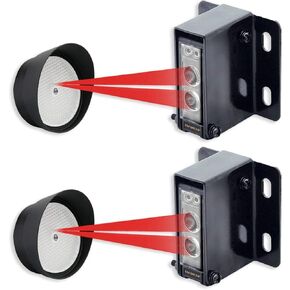- Shopping, made easy.
- /
- Get the app!
Product Overview:
The HC-SR501 is an infrared-based automatic control module designed with the LHI778 sensor, known for its high sensitivity and strong reliability. It operates in a voltage-controlled mode and is widely used in various automatic sensing devices, particularly in battery-powered automatic control products.
Product Name: HC-SR501 PIR Motion Sensor Module
PCB Dimensions: 32mm (L) × 24mm (W) × 18mm (H) / 1.26in × 0.94in × 0.71in
Lens Diameter: 23mm / 0.91in
Product Weight: 6.4g / 0.23oz
Operating Voltage Range: 4.5-20V DC
Static Current: < 50uA
Output Level: High 3.3V / Low 0V
Trigger Modes:
L: Non-repeatable trigger
H: Repeatable trigger (default setting)
Delay Time: 0.5-200 seconds (adjustable) — can be set to range from fractions of a second to several minutes.
Block Time: 2.5 seconds (default) — can be set to range from fractions of a second to several seconds.
Sensing Angle: <100° cone angle
Sensing range: within 7 meters/23ft
Operating Temperature: -15°C to +70°C
Usage Instructions:
Initialization:
After powering on, the module requires about one minute for initialization. During this time, it may output signals 0-3 times intermittently. After the initialization phase, the module enters standby mode.
Avoid Interference:
Try to avoid direct exposure of the sensor lens to sources of light, such as lamps, as this might introduce interference signals and cause false triggering.
The environment should also avoid moving air, as wind can interfere with the sensor's performance.
Sensor Mechanics:
The module uses a dual-element sensor. The sensor window is rectangular, with two elements (A and B) located at opposite ends of the long side. When a person moves from left to right or right to left across the sensor, the infrared spectrum reaches the two elements at different times and distances, creating a differential signal. The greater the difference, the more sensitive the sensor becomes.
However, if a person approaches the sensor directly (front-to-back) or moves up or down across its field of view, there is no change in the infrared spectrum distance between the two elements, resulting in poor or no detection.
Installation Tips:
To ensure optimal performance, the direction of the sensor's dual elements should be as parallel as possible to the primary direction of human movement. This ensures that the sensor detects the person as they pass across both elements in sequence. (Note: To increase the sensing angle, this module uses a circular lens, allowing detection from all four sides. However, the left and right sides of the sensor remain more sensitive than the top and bottom. Therefore, it is still recommended to follow the above installation guidelines for best results.)
 DEVMO 2PCS Microwave Doppler Radar Motion Detector Sensor RCWL-0516 Module Board Switch Compatible with Ar-duino Raspberry PI,Human Rat Cat Detector
KWD 5
DEVMO 2PCS Microwave Doppler Radar Motion Detector Sensor RCWL-0516 Module Board Switch Compatible with Ar-duino Raspberry PI,Human Rat Cat Detector
KWD 5
 1/2 Mile Long Range Wireless Driveway Alarm Weather Resistant Motion Detector & Sensor - Home Security Alert System - Monitor & Protect Oudoor&Indoor Property
KWD 8.500
1/2 Mile Long Range Wireless Driveway Alarm Weather Resistant Motion Detector & Sensor - Home Security Alert System - Monitor & Protect Oudoor&Indoor Property
KWD 8.500
 ENERLITES Ultrasonic and PIR Dual Technology Occupancy Sensor, 360 Degree Field of View, 1,600 Sq Ft Coverage, Commercial Grade, MDC-50V-W, White
KWD 34
ENERLITES Ultrasonic and PIR Dual Technology Occupancy Sensor, 360 Degree Field of View, 1,600 Sq Ft Coverage, Commercial Grade, MDC-50V-W, White
KWD 34
 -11%
Seco-Larm E-936-S45RRGQ Retro Reflective Photoelectric Beam Sensor, 45ft (14m) Sensing Range, Weatherproof (IP66) Construction for Indoor/Outdoor use, Pre-Wired 6ft (1.8m) Cord, Pack of 2
KWD 48.500
-11%
Seco-Larm E-936-S45RRGQ Retro Reflective Photoelectric Beam Sensor, 45ft (14m) Sensing Range, Weatherproof (IP66) Construction for Indoor/Outdoor use, Pre-Wired 6ft (1.8m) Cord, Pack of 2
KWD 48.500